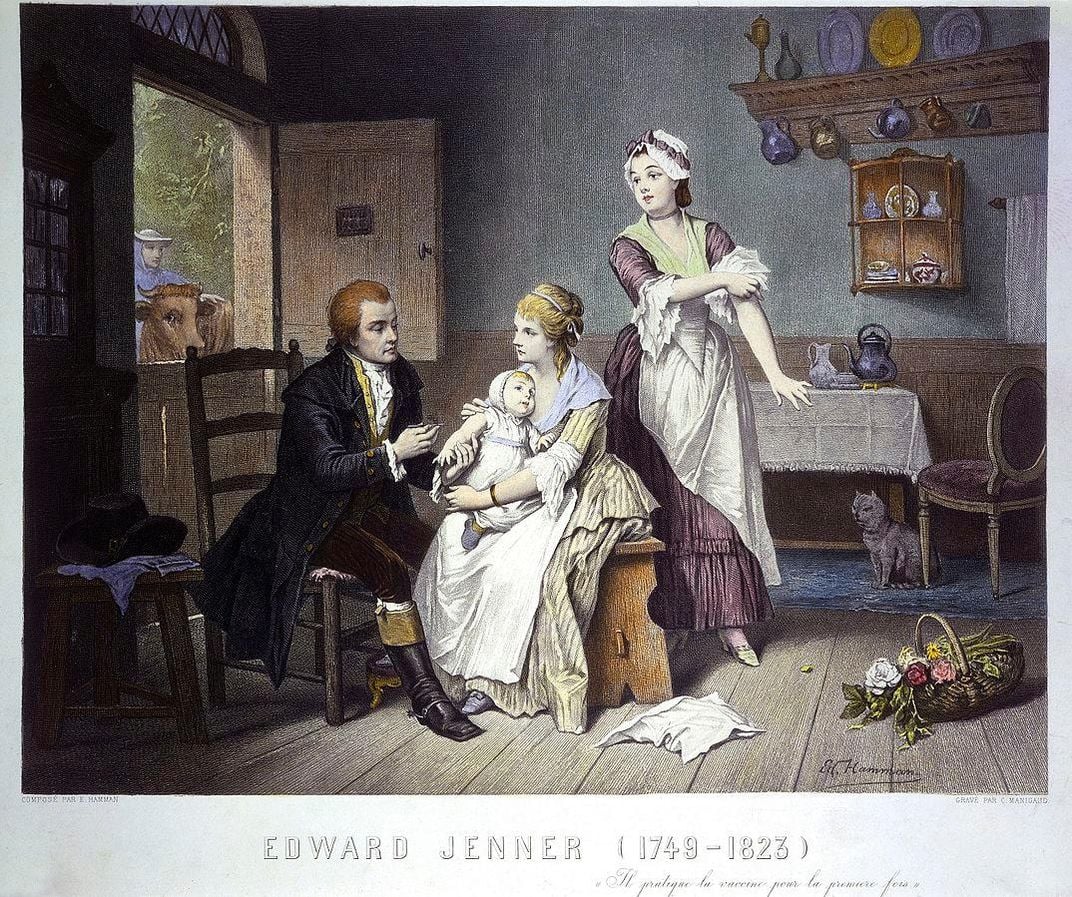Letter From ‘Father of Vaccination’ Edward Jenner Sold at Auction
Jenner wrote that new research ‘put a stop to the sneers’ of ‘little minded persons’
/https://tf-cmsv2-smithsonianmag-media.s3.amazonaws.com/filer/d3/6c/d36c57f5-5d0c-4288-988f-9940fed6ce56/jenner_letter.jpg)
An 1802 letter written by vaccination pioneer Edward Jenner to a colleague has sold at auction in the United Kingdom for £7,000 ($9,740).
Rod Minchin reports for PA Media that Jenner was writing to John Glover Loy, a doctor in Whitby, England. Four years earlier, Jenner had published a groundbreaking study on the use of cowpox as an inoculation against the smallpox virus. In the letter, he praised work Loy had done that vindicated Jenner’s ideas about the origins of cowpox.
“I know of no production on the vaccine subject which has afforded me more satisfaction, since it was first brought before the public, than yours,” he wrote, adding that the new research “has effectually put a stop to the sneers of those little minded persons who think everything impossible which does not come within the narrow sphere of their own comprehension.”
Chris Albury, a director of Dominic Winter Auctioneers, which sold the letter on behalf of Loy’s descendants, tells PA that Jenner’s letters rarely come up for auction, even rarer was one that discussed Jenner's most famous achievement.
“This letter also offers insights into Dr. Jenner’s character and true feelings as he battled with the medical establishment while promoting his ideas,” Albury says.
Prior to Jenner’s discoveries, some people used a different form of inoculation known as variolation, which involved deliberately infecting a patient with smallpox. Per the National Institutes of Health’s History of Medicine, variolation was first developed in Asia and used in Africa, India and the Ottoman Empire before 1700. By Jenner’s time, Europeans and people in the United States used it as well.
Jenner’s innovation began with the belief held by many people in England at the time that farmers who caught cowpox from their cows couldn’t get smallpox. Cowpox is a mild disease in both cows and humans and rarely caused much trouble for those who got it. Jenner experimented with the cowpox virus, using material from a pox on a milkmaid who had acquired the disease to infect the eight-year-old son of his gardener. When Jenner later variolated the boy in the usual way, he did not develop symptoms of smallpox.

But, Albury tells PA, many of his contemporaries were still uncomfortable with inoculation.
“One can understand some of the anti-vaccination skeptics who were nonplussed by the idea of using cowpox pus to inoculate people against smallpox in terms of hygiene and its ‘unchristian’ practice coupled with distrust in medicine generally,” he says.
Variolation provided a great deal of protection against smallpox, which had a 30 percent mortality rate. But it killed 1 to 2 percent of people who received it and risked causing more transmission of the deadly disease. Jenner’s vaccinations were much safer. By 1840, Aubry says, the British government banned variolation and provided cowpox vaccination for free.
Atlas Obscura’s Matthew Taub writes that, by some counts, Jenner is responsible for the most lives saved of any person in history. And Jenner’s treatment was so significant that it gave us the generic word vaccine, which comes from the Latin word for cow, vacca.
But the letter to Loy illustrates the importance of a different animal in vaccination history: the horse. In his original publication on cowpox inoculation, Jenner suggested that cowpox originated in horses, as a disease known as horsepox or grease, and only later spread to cows. Loy’s work determined that people infected with grease exhibited the same kinds of lesions as those exposed to cowpox and also received protection against smallpox.
José Esparza, a virologist at the University of Maryland School of Medicine, tells Atlas Obscura that Jenner actually experimented with both cowpox and horsepox, but he generally focused on cowpox in his public statements.
“Jenner was attracted to the story of the milkmaid and thought that it was a good story to promote vaccination,” Esparza says. “It was a marketing thing.”
Esparaza’s own research has found that Europeans in the 19th century used both cowpox and horsepox in vaccination, and that modern vaccine strains may have their origins in horsepox.
/https://tf-cmsv2-smithsonianmag-media.s3.amazonaws.com/accounts/headshot/Livia_lg_thumbnail.png)
/https://tf-cmsv2-smithsonianmag-media.s3.amazonaws.com/accounts/headshot/Livia_lg_thumbnail.png)